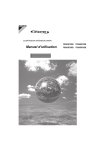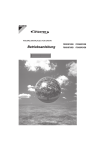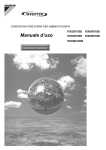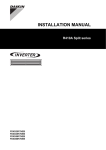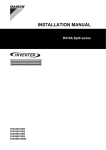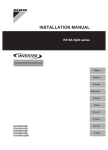Download Operation Manual
Transcript
DAIKIN ROOM AIR CONDITIONER Operation Manual FDXS25F2VEB FDXS60F2VEB FDXS35F2VEB FDXS50F2VEB English Deutsch Français Nederlands Español Italiano Ελληνικά Portugues Русский Türkçe CONTENTS READ BEFORE OPERATION Safety precautions ........................................ 2 Names of parts .............................................. 4 CARE Care and Cleaning ........................................ 6 TROUBLE SHOOTING Trouble Shooting ........................................... 8 The original instructions are written in English. All other languages are translations of the original instructions. 1 READ BEFORE OPERATION Safety precautions • • • • Keep this manual where the operator can easily find them. Read this manual attentively before starting up the unit. For safety reason the operator must read the following cautions carefully. This manual classifies precautions into WARNING and CAUTION. Be sure to follow all precautions below: they are all important for ensuring safety. • The sound power is less than 70dB(A). WARNING CAUTION If you do not follow these instructions exactly, the unit may If you do not follow these instructions exactly, the unit may cause property damage, personal injury or loss of life. cause minor or moderate property damage or personal injury. Never do. Be sure to follow the instructions. Be sure to earth the air conditioner. Never cause the air conditioner (including the remote controller) to get wet. Never touch the air conditioner (including the remote controller) with a wet hand. WARNING • In order to avoid fire, explosion or injury, do not operate the unit when harmful, among which flammable or corrosive gases, are detected near the unit. • It is not good for health to expose your body to the air flow for a long time. • Do not put a finger, a rod or other objects into the air outlet or inlet. As the fan is rotating at a high speed, it will cause injury. • Do not attempt to repair, relocate, modify or reinstall the air conditioner by yourself. Incorrect work will cause electric shocks, fire etc. For repairs and reinstallation, consult your Daikin dealer for advice and information. • The refrigerant used in the air conditioner is safe. Although leaks should not occur, if for some reason any refrigerant happens to leak into the room, make sure it does not come in contact with any flame as of gas heaters, kerosene heaters or gas range. • If the air conditioner is not cooling (heating) properly, the refrigerant may be leaking, so call your dealer. When carrying out repairs accompanying adding refrigerant, check the content of the repairs with our service staff. • Do not attempt to install the air conditioner by your self. Incorrect work will result in water leakage, electric shocks or fire. For installation, consult the dealer or a qualified technician. • In order to avoid electric shock, fire or injury, if you detect any abnormally such as smell of fire, stop the operation and turn off the breaker. And call your dealer for instructions. • Depending on the environment, an earth leakage breaker must be installed. Lack of an earth leakage breaker may result in electric shocks or fire. • The air conditioner must be earthed. Incomplete earthing may result in electric shocks. Do not connect the earth line to a gas pipe, water pipe, lightning rod, or a telephone earth line. CAUTION • In order to avoid any quality deterioration, do not use the unit for cooling precision instruments, food, plants, animals or works of art. • Never expose little children, plants or animals directly to the air flow. • This appliance is intended to be used by expert or trained users in shops, in light industry and on farms, or for commercial and household use by lay persons. 2 • Do not place appliances which produce open fire in places exposed to the air flow from the unit or under the indoor unit. It may cause incomplete combustion or deformation of the unit due to the heat. • Do not block air inlets nor outlets. Impaired air flow may result in insufficient performance or trouble. • Do not stand or sit on the outdoor unit. Do not place any object on the unit to avoid injury, do not remove the fan guard. • Do not place anything under the indoor or outdoor unit that must be kept away from moisture. In certain conditions, moisture in the air may condense and drip. • After a long use, check the unit stand and fittings for damage. • Do not touch the air inlet and alminum fins of outdoor unit. It may cause injury. • This appliance is not intended for use by persons, including children, with reduced physical, sensory or mental capabilities, or lack of experience and knowledge, unless they have been given supervision or instruction concerning use of the appliance by a person responsible for their safety. Children shall be supervised to ensure that they do not play with the appliance. • To avoid oxygen deficiency, ventilate the room sufficiently if equipment with burner is used together with the air conditioner. • Before cleaning, be sure to stop the operation, turn the breaker off or pull out the supply cord. • Do not connect the air conditioner to a power supply different from the one as specified. It may cause trouble or fire. • Arrange the drain hose to ensure smooth drainage. Incomplete draining may cause wetting of the building, furniture etc. • Do not place things that must be kept dry under the indoor unit. Water may drip from the indoor unit if the humidity is 80% or above or when the drain outlet is clogged or the air-filter is dirtied. • Do not place objects in direct proximity of the outdoor unit and do not let leaves and other debris accumulate around the unit. Leaves are a hotbed for small animals which can enter the unit. Once in the unit, such animals can cause malfunctions, smoke or fire when making contact with electrical parts. • Do not operate the air conditioner with wet hands. • Do not wash the indoor unit with excessive water, only use a slightly wet cloth. • Do not place things such as vessels containing water or anything else on top of the unit. Water may penetrate into the unit and degrade electrical insulations, resulting in an electric shock. Installation site. To install the air conditioner in the following types of environments, consult the dealer. • Places with an oily ambient or where steam or soot occurs. • Salty environment such as coastal areas. • Places where sulfide gas occurs such as hot springs. • Places where snow may block the outdoor unit. The drain from the outdoor unit must be discharged to a place of good drainage. Consider nuisance to your neighbours from noises. For installation, choose a place as described below. • A place solid enough to bear the weight of the unit which does not amplify the operation noise or vibration. • A place from where the air discharged from the outdoor unit or the operation noise will not annoy your neighbours. Electrical work. • For power supply, be sure to use a separate power circuit dedicated to the air conditioner. System relocation. • Relocating the air conditioner requires specialized knowledge and skills. Please consult the dealer if relocation is necessary for moving or remodeling. 3 Names of parts Indoor Unit 1 4 OPTIONAL 2 3 ACCESSORIES • This indoor unit at least requires one of the remote controllers. Refer to the operation manual delivered with remote controller. Remote controller 4 Outdoor Unit 5 6 7 9 8 Indoor Unit 1. Air outlet 2. Air outlet grille: (Field supply) • Appearance of the Air outlet grille and Air inlet grille may differ with some models. 3. Suction grille: (Option) • Appearance of the suction grille and Air inlet grille may differ with some models. 4. Air inlet • The operation mode refers to the following table. Mode FDXS Outdoor Unit 5. Air inlet: (Back and side) AUTO Temperature setting 25°C 6. Refrigerant piping and inter-unit cable 8. Earth terminal: • It is inside of this cover. 7. Drain hose 9. Air outlet Air flow rate AUTO Appearance of the outdoor unit may differ from some models. Please note • If you are not going to use the air conditioner for a long period, for example in spring or autumn, turn the breaker OFF. • Use the air conditioner in the following conditions. MODE Operating conditions Outdoor temperature: <2MXS> 10-46°C <3/4/5MXS> –10-46°C COOL <RXS> –10-46°C Indoor temperature: 18-32°C Indoor humidity: 80% max. HEAT If operation is continues out of this range • A safety device may work to stop the operation. (In multi system, it may work to stop the operation of the outdoor unit only.) • Condensation may occur on the indoor unit and drip. Outdoor temperature: <2/3/4/5MXS> –15-24°C • A safety device may work to stop the <RXS> –15-24°C operation. Indoor temperature: 10-30°C • Operation outside this humidity or temperature range may cause a safety device to disable the system. 5 CARE Care and Cleaning CAUTION • Only a qualified service person is allowed to perform maintenance. • Before cleaning, be sure to stop the operation and turn the breaker OFF. Cleaning the air filter 1.Removing the air filter. • Rear suction Pull the bottom side of the air filter backwards, over the bends. (2 bends for 25/35 type, 3 bends for 50/60 type) • Bottom suction Pull the filter over the bends (2 bends for 25/35 type, 3 bends for 50/60 type) situated at the backside of the unit. 2.Cleaning the air filter. Remove dust from the air filter using a vacuum cleaner and gently rinse them in cool water. Do not use detergent or hot water to avoid filter shrinking or deformation. After cleaning dry them in the shade. 3.Replacing the air filter. • Rear suction Hook the filter behind the flap situated at the top of the unit and push the other side gently over the bends. (2 bends for 25/35 type, 3 bends for 50/60 type) • Bottom suction Hook the filter behind the flap situated at the middle of the unit and push the other side gently over the bends. (2 bends for 25/35 type, 3 bends for 50/60 type) Main unit Force Filter Force In case of back side Attach the filter to the main unit while pushing down on the bends. (2 bends for 25/35 type, 3 bends for 50/60 type) In case of bottom side 6 Cleaning the drain pan • Clean the drain pan periodically, or drain piping may be clogged with dust and may result in water leakage. Ask your DAIKIN dealer to clean them. • Prepare a cover locally to prevent any dust in the air around the indoor unit from getting in the drain pan, if there is a great deal of dust present. CAUTION • Do not operate the air conditioner without filters, this to avoid dust accumulation inside the unit. • Do not remove the air filter except when cleaning. Unnecessary handling may damage the filter. • Do not use gasoline, benzene, thinner, polishing powder, liquid insecticide, It may cause discoloring or warping. • Do not let the indoor unit get wet. It may cause an electric shock or a fire. • Operation with dusty air filters lowers the cooling and heating capacity and wastes energy. • The suction grille is option. • Do not use water or air of 50°C or higher for cleaning air filters and outside panels. • Ask your DAIKIN dealer how to clean it. Check Check that the base, stand and other fittings of the outdoor unit are not decayed or corroded. Check that nothing blocks the air inlets and the outlets of the indoor unit and the outdoor unit. Check that the drain comes smoothly out of the drain hose during COOL or DRY operation. • If no drain water is seen, water may be leaking from the indoor unit. Stop operation and consult the service shop if this is the case. Before a long idle period 1. Operate the “FAN only” for several hours on a fine day to dry out the inside. • Press “MODE selector button” and select “FAN” operation. • Press “ON/OFF button” and start operation. 2. Clean the air filters and set them again. 3. Take out batteries from the remote controller. 4. Turn OFF the breaker for the room air conditioner. • When a multi outdoor unit is connected, make sure the heating operation is not used at the other room before you use the fan operation. 7 TROUBLE SHOOTING Trouble Shooting These cases are not troubles. The following cases are not air conditioner troubles but have some reasons. You may just continue using it. Case Explanation Operation does not start soon. • When ON/OFF button was pressed soon after operation was stopped. • When the mode was reselected. • This is to protect the air conditioner. You should wait for about 3 minutes. Hot air does not flow out soon after the start of heating operation. • The air conditioner is warming up. You should wait for 1 to 4 minutes. (The system is designed to start discharging air only after it has reached a certain temperature.) The heating operation stops suddenly and a flowing sound is heard. • The system is taking away the frost on the outdoor unit. You should wait for about 3 to 8 minutes. The outdoor unit emits water or steam. In HEAT mode • The frost on the outdoor unit melts into water or steam when the air conditioner is in defrost operation. In COOL or DRY mode • Moisture in the air condenses into water on the cool surface of outdoor unit piping and drips. Mists come out of the indoor unit. This happens when the air in the room is cooled into mist by the cold air flow during cooling operation. The indoor unit gives out odour. This happens when smells of the room, furniture, or cigarettes are absorbed into the unit and discharged with the air flow. (If this happens, we recommend you to have the indoor unit washed by a technician. Consult the service shop where you bought the air conditioner.) The outdoor fan rotates while the air conditioner is not in operation. After operation is stopped: • The outdoor fan continues rotating for another 30 seconds for system protection. While the air conditioner is not in operation: • When the outdoor temperature is very high, the outdoor fan starts rotating for system protection. The operation stopped suddenly. (OPERATION lamp is on.) For system protection, the air conditioner may stop operating on a sudden large voltage fluctuation. It automatically resumes operation in about 3 minutes. 8 Check again. Please check again before calling a repair person. Case The air conditioner does not operate. (OPERATION lamp is off.) Check • • • • Hasn’t a breaker turned OFF or a fuse blown? Isn’t it a power failure? Are batteries set in the remote controller? Is the timer setting correct? Cooling (Heating) effect is poor. • Are the air filters clean? • Is there anything to block the air inlet or the outlet of the indoor and the outdoor units? • Is the temperature setting appropriate? • Are the windows and doors closed? • Are the air flow rate and the air direction set appropriately? Operation stops suddenly. (OPERATION lamp blinks.) • Are the air filters clean? • Is there anything to block the air inlet or the outlet of the indoor and the outdoor units? Clean the air filters or take all obstacles away and turn the breaker OFF. Then turn it ON again and try operating the air conditioner with the remote controller. If the lamp still blinks, call the service shop where you bought the air conditioner. • Are operation modes all the same for indoor units connected to outdoor units in the multi system? If not, set all indoor units to the same operation mode and confirm that the lamps blink. Moreover, when the operation mode is in “AUTO”, set all indoor unit operation modes to “COOL” or “HEAT” for a moment and check again that the lamps are normal. If the lamps stop blinking after the above steps, there is no malfunction. (page 18.) An abnormal functioning happens during operation. • The air conditioner may malfunction with lightning or radio waves. Turn the breaker OFF, turn it ON again and try operating the air conditioner with the remote controller. 9 Call the service shop immediately. WARNING When an abnormality (such as a burning smell) occurs, stop operation and turn the breaker OFF. Continued operation in an abnormal condition may result in troubles, electric shocks or fire. Consult the service shop where you bought the air conditioner. Do not attempt to repair or modify the air conditioner by yourself. Incorrect work may result in electric shocks or fire. Consult the service shop where you bought the air conditioner. If one of the following symptoms takes place, call the service shop immediately. The power cord is abnormally hot or damaged. An abnormal sound is heard during operation. The safety breaker, a fuse, or the earth leakage breaker cuts off the operation frequently. A switch or a button often fails to work properly. There is a burning smell. Water leaks from the indoor unit. After a power failure The air conditioner automatically resumes operation in about 3 minutes. You should just wait for a while. Turn the breaker OFF and call the service shop. Lightning If lightning may strike the neighbouring area, stop operation and turn the breaker OFF for system protection. Disposal requirements Dismantling of the unit, treatment of the refrigerant, of oil and of other parts must be done in accordance with relevant local and national legislation. We recommend periodical maintenance. In certain operating conditions, the inside of the air conditioner may get foul after several seasons of use, resulting in poor performance. It is recommended to have periodical maintenance by a specialist aside from regular cleaning by the user. For specialist maintenance, contact the service shop where you bought the air conditioner. The maintenance cost must be born by the user. Important information regarding the refrigerant used. This product contains fluorinated greenhouse gases covered by the Kyoto Protocol. Refrigerant type:R410A GWP(1) value:1975 (1) GWP = global warming potential Periodical inspections for refrigerant leaks may be required depending on European or local legislation. Please contact your local dealer for more information. 10 4P324974-1B 2012.12 Copyright 2012 Daikin













